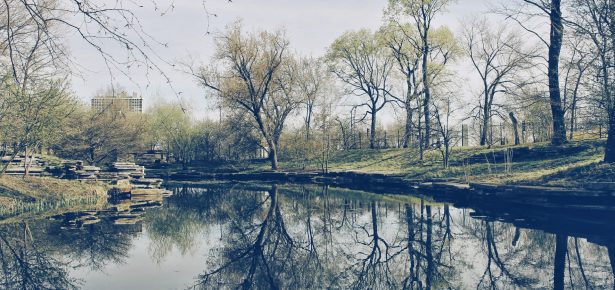
In The Age of Anxiety (1947), begun during the Second World War, W.H. Auden observed that ‘in times of crisis, display of even the crudest kind of affection between people can be profoundly ennobling, a symbol of the love the world is so desperately in need of.[1] Indeed, in the trenches of the First World War, Lance-Corporal D.H. Fenton was following his heart – and not a wholly unknown practice among comrades-in-arms – when, as his friend Jim was hit, ‘I held him in my arms to the end and, when his soul had departed, I kissed him’.[2]
In situations of extremity, the body has habitually moved in to fill in the gap left by language. In The Man with Night Sweats (1992), written in the shadow of the AIDS crisis, Thom Gunn remembered a friend, recently dead, visiting another, ‘with terrible hothouse shiver’, in a hospital in New York:
And you perceived that he
Had to be comforted.
You climbed in there beside him
And hugged him plain in view,
Though you were sick enough,
And had your own fears too.[3]

For Gunn, it was a time of ‘unlimited embrace’, captured famously by ‘the photo that changed the face of AIDS’: that of the 32-year old activist David Kirby as he is held and comforted in his final moments by his father; on the right-hand side, his sister comforts her daughter, completing this modern Pieta.[4]
What makes Covid 19 different from wars or previous pandemics is that it threatens to take away these small gestures and rituals, those hugs, pats and caresses by which we live, love and mourn. Social distancing is essential to check the spread of the virus but, for many, those two metres or six feet will determine not only how they reach out to the living but how they make peace with the dead. If trauma, for Freud, was a moment of ‘missed encounter’ (in Cathy Caruth’s celebrated phrase), the pandemic has grotesquely literalised it. The pathogen has somewhat narrowed the gap between whether we are six or six thousand miles away from those we love. The idea that many of us, who live and work abroad, cannot travel back even in the case of a family emergency is bewildering, but equally painful it is for those not being able to be with a vulnerable mother or a friend on borrowed time even when they are just round the corner. Imagine the plight of the mother of Ismail Mohamed Abdulwahab in London: she was not allowed to visit her 13-year old dying boy in hospital, only a few miles from home, nor could the family, self-isolating, attend the funeral. The sight of Ismail’s small coffin being lowered by PPE-clad men, without any family present, generated a wave of grief and empathy Muslim lives have seldom elicited in the UK.[5] Instead of ‘unlimited embrace’, Covid time will be for thousands one of infinite regret.

The pathogen has cruelly turned us all into too solid flesh even as much that was solid melts into cloud. Far more spectacularly than any modern machine, against which Lawrence, Forster and Tagore railed so bitterly, the virus has deprived us of the most intimate of our senses in everyday social discourse. What makes the practice of distancing so challenging is that it is the denial of the reality of our bodies, of urges more primal than sex or love: our need to come together physically, to be spontaneous and expressive with our bodies, as if sociability lodged itself in the corpuscles of our skin. For many who are very frail or disabled, touch is the only language available. Neither history nor literature, neither Camus nor Marquez, provides any precedent for that most strenuous task of all, to emotionally grasp how distance, not proximity, can be the sign of care, of our love for each other, when our senses tell us otherwise. Medical knowledge and human nature have never been more at war.

Instead, the face on the screen is entering our lives ever more intimately, not as Barthes’ ‘idea’ or ‘event’, but with something approximating the mutuality of the embrace: I smile because you smile, across continents. The wonder of digital technology conveys the face in its wondrous morphology instantly as it registers, recognises and responds to mine; simultaneity and reciprocation create the semblance of spontaneity, however imperfectly. With the Covid lockdown and travel ban, the online platforms, Zoom and WhatsApp, have facilitated new modes and kinds of intimacies, across various thresholds, sometimes heartbreakingly so. Rajesh Jayaseelan, a 44-year old migrant Uber driver from India, was evicted from his London flat for catching Covid and forced to isolate in his car.[6] Before he was put on ventilator, the hospital organised a video-call with his wife and two children, in Bangalore, who were able to communicate with his intubated face. That video-call, on the day before his death, would be their final memory, this pandemic’s equivalent to the AIDS photograph.
In a time of necessary social distancing, the
face will increasingly be called upon to perform the work of touch, our eyes
and lips the magic of fingers. For most people, this period will pass, but for
some, it may last for a long time. Over the last two months, I have constantly
been in touch, virtually, with my hitherto relentlessly social and active
72-year old widowed mother in Kolkata. Being diabetic, she has to isolate, by
herself and indefinitely, in her house. For the last few years, I had resigned
myself to seeing her face getting increasingly lined; what now makes me go cold
is the thought of how many such faces, seeking to reach us, touch us, from
their solitary cells, may gradually turn to stone.
[1] W.H. Auden, The Age of Anxiety, 111.
[2] See Santanu Das, ‘The Dying Kiss’, https://emotionsblog.history.qmul.ac.uk/2014/03/the-dying-kiss/
[3] Thom Gunn, ‘Memory Unsettled’ in The Man with Night Sweats, 76.
[4] https://www.life.com/history/behind-the-picture-the-photo-that-changed-the-face-of-aids/.
[5] https://www.mirror.co.uk/news/uk-news/heartbreaking-pictures-show-lonely-funeral-21809116
[6] https://www.theguardian.com/world/2020/apr/17/uber-driver-dies-from-covid-19-after-hiding-it-over-fear-of-eviction
Latest Comments
Have your say!